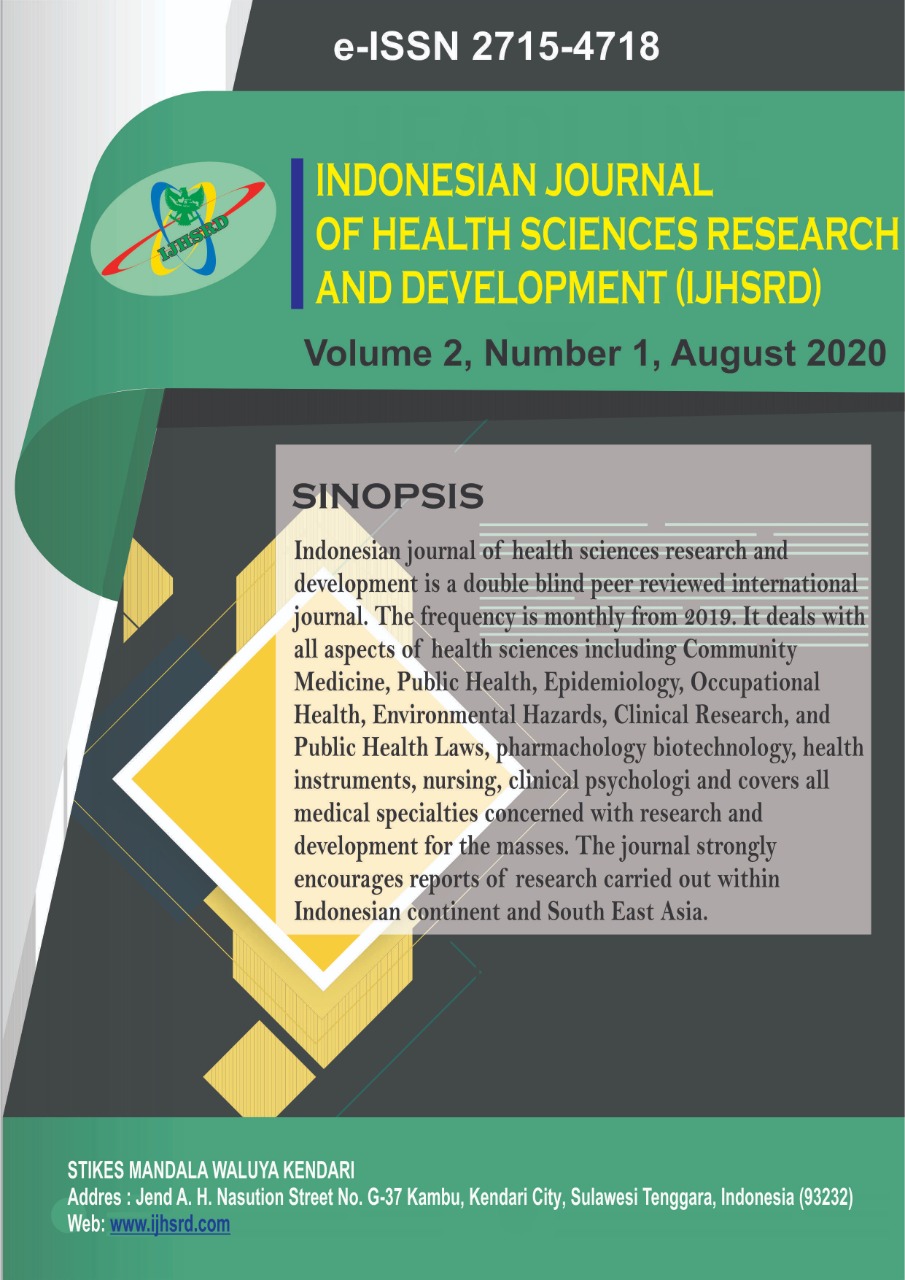Main Article Content
Abstract
Background: Tuberculosis is a contagious disease that is still a problem in the world today, not only in developing countries but also in developed countries. Likewise in Kendari City in 2012 - 2017. Efforts that can be made to prevent the increasing number of tuberculosis cases in the future is to make predictions. This study aims to determine the time series analysis in predicting the incidence of tuberculosis by sex and working area of ??health centre in the city of Kendari in 2018-2022.
Methods: This type of research is quantitative descriptive with times series analysis design. The source of the research data was obtained from the Kendari City Health Institution, Southeast Sulawesi Province, namely the data on the case of pulmonary TB which included the gender and working area of ??the Health Centre in 2012 - 2017 in the city of Kendari to be processed and analyzed in time series using the trend method approach into 3 models. linear trend, quadratic trend, and an exponential trend.
Results: The results showed that the best model for the prediction of pulmonary TB cases in Kendari City was the quadratic model. Cases of tuberculosis by sex are predicted to decrease in the period 2018 to 2022, with an average decline with an average decrease of 79 cases in men and 286 cases in women. Pulmonary TB cases based on the health centre area are predicted to experience an increase in cases from 2018 until 2022 with the highest average increase being in the Kemaraya Health Centre area. While the highest average decrease in cases in the area of ??the Eye Health Center. It is expected to become information for policymakers so that prevention and promotion efforts can be made early to the community.
Conclusion: Based on the results of the study, the conclusion of this study is the Science, knowledge about risk and Patient Contact History is a risk factor for tuberculosis in the work area of Puuwatu Health Centre, Kendari City.
Keywords
Article Details

This work is licensed under a Creative Commons Attribution-ShareAlike 4.0 International License.
References
- Mertaniasih NM. Buku Ajar Tuberkulosis Diagnostik Mikrobiologis: Airlangga University Press; 2019.
- Organization WH. Global tuberculosis report 2017: World Health Organization; 2017. Report No: 9241565055. 2018.
- WHO TFSN. 104. WHO; 2018.
- Kemenkes R. Tuberkulosis. Jakarta: Pusat Data dan Informasi Kementrian Kesehatan RI. 2018.
- Indonesia K. Hasil utama riskesdas 2018. Jakarta: Badan Penelitian dan Pengembangan Kesehatan. 2018.
- Kendari DKK. Profil Dinas Kesehatan Kota Kendari. 2018.
- Tenggara DKPS. Profil Kesehatan Provinsi Sulawesi Tenggara Tahun 2018. Kendari: Dinas Kesehatan Provinsi Sulawesi Tenggara. 2019.
- Puuwatu P. Profil Puskesmas Puuwatu Tahun 2018. 2019.
- Astuti S. Hubungan tingkat pengetahuan dan sikap masyarakat terhadap upaya pencegahan penyakit Tuberkulosis di rw 04 Kelurahan Lagoa Jakarta Utara Tahun 2013. 2013.
- Putera I, Pakasi TA, Karyadi E. Knowledge and perception of tuberculosis and the risk to become treatment default among newly diagnosed pulmonary tuberculosis patients treated in primary health care, East Nusa Tenggara: a retrospective study. BMC research notes. 2015;8(1):238.
- Ferrara G, Murray M, Winthrop K, Centis R, Sotgiu G, Migliori GB, et al. Risk factors associated with pulmonary tuberculosis: smoking, diabetes and anti-TNF? drugs. Current opinion in pulmonary medicine. 2012;18(3):233-40.
- George EL, Iype T, Cherian A, Chandy S, Kumar A, Balakrishnan A, et al. Predictors of mortality in patients with meningeal tuberculosis. Neurology India. 2012;60(1):18.
- Bowling A. Research methods in health: investigating health and health services: McGraw-hill education (UK); 2014.
- Uchenna OU, Chukwu J, Oshi D, Nwafor C, Meka A. Assessment of tuberculosis-related knowledge, attitudes and practices in Enugu, South East Nigeria. Journal of infectious Diseases and Immunity. 2014;6(1):1-9.
- Buton LD, Fadmi FR, Mulyani S. The Relation between Knowledge, Stress and Salt Consumption with Incidence of Hypertension in Elderly Woman Out Patients in General Hospital of Bahteramas Southeast Sulwesi Province. Indian Journal of Public Health Research & Development. 2018;9(6):385-9.
- Fadmi FR. ANALISIS REGRESI LINIER FAKTOR DOMINAN KEPATUHAN MINUM OBAT PADA PENDERITA TUBERKULOSIS PARU DI WILAYAH KERJA PUSKESMAS SAMPARA. Jurnal Kesehatan Preventif. 2018;8(7):26-42.
- Jeyashree K, Kathirvel S, Shewade HD, Kaur H, Goel S. Smoking cessation interventions for pulmonary tuberculosis treatment outcomes. Cochrane Database of Systematic Reviews. 2016(1).
- Yen Y, Yen M, Lin Y, Lin Y, Shih H, Li L, et al. Smoking increases risk of recurrence after successful anti-tuberculosis treatment: a population-based study. The International Journal of Tuberculosis and Lung Disease. 2014;18(4):492-8.
- North CM, Allen JG, Okello S, Sentongo R, Kakuhikire B, Ryan ET, et al. HIV infection, pulmonary tuberculosis, and COPD in rural Uganda: a cross-sectional study. Lung. 2018;196(1):49-57.
- Du Y, Cui X, Sidorenkov G, Groen H, Vliegenthart R, Heuvelmans M, et al., editors. Lung Cancer Occurrence Attributable to Passive Smoking Among Never Smokers in China: A Systematic Review and Meta-Analysis. Journal of Thoracic Oncology; 2019: ELSEVIER SCIENCE INC STE 800, 230 PARK AVE, NEW YORK, NY 10169 USA.
- Mathew A, David T, Thomas K, Kuruvilla P, Balaji V, Jesudason MV, et al. Risk factors for tuberculosis among health care workers in South India: a nested case–control study. Journal of clinical epidemiology. 2013;66(1):67-74.
- Fox GJ, Barry SE, Britton WJ, Marks GB. Contact investigation for tuberculosis: a systematic review and meta-analysis. European Respiratory Journal. 2013;41(1):140-56.
